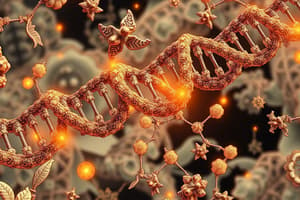Podcast
Questions and Answers
What is the name of the rule that describes the complementary base pairing in DNA?
What is the name of the rule that describes the complementary base pairing in DNA?
Which of these is NOT a characteristic of the DNA double helix?
Which of these is NOT a characteristic of the DNA double helix?
What is the primary function of DNA?
What is the primary function of DNA?
What is the basic structural unit of nucleic acids?
What is the basic structural unit of nucleic acids?
Signup and view all the answers
Which of the following is NOT a key component of the central dogma of molecular biology?
Which of the following is NOT a key component of the central dogma of molecular biology?
Signup and view all the answers
Flashcards
Nucleic Acid
Nucleic Acid
Biomolecules that store and transmit genetic information, including DNA and RNA.
Nucleotide
Nucleotide
The basic building block of nucleic acids, composed of a sugar, phosphate group, and a nitrogenous base.
Chargaff’s rule
Chargaff’s rule
In DNA, the amount of adenine equals thymine and the amount of cytosine equals guanine.
Double Helix
Double Helix
Signup and view all the flashcards
Central dogma
Central dogma
Signup and view all the flashcards
Study Notes
Nucleic Acids: DNA & RNA Structure and Function
- Nucleic acids are linear polymers
- They store and pass genetic information
Nucleotide Structure
- Nucleotides are the building blocks
- Each nucleotide contains a phosphate group, a sugar (deoxyribose in DNA, ribose in RNA), and a nitrogenous base
- Nitrogenous bases include purines (adenine, guanine) and pyrimidines (cytosine, thymine in DNA, uracil in RNA)
DNA Structure
- DNA is a double helix
- Two antiparallel strands wound around each other
- The strands are held together by hydrogen bonds between complementary nitrogenous bases (A with T, and G with C)
- DNA has a sugar-phosphate backbone
RNA Structure
- RNA is typically single-stranded
- The sugar in RNA is ribose
- The nitrogenous base uracil replaces thymine in RNA
- Several types of RNA exist including mRNA, tRNA, and rRNA
- Several other non-coding RNAs function in gene regulation
Chargaff's Rule
- In DNA, the amount of adenine equals the amount of thymine, and the amount of guanine equals the amount of cytosine
DNA Packaging
- DNA is packaged into structures called chromosomes
- DNA wraps around proteins called histones to form nucleosomes
- Further packaging coils the nucleosomes into a tightly packed structure
Central Dogma
- DNA -> RNA -> Protein
- DNA replication makes copies of DNA
- Transcription converts DNA to RNA
- Translation converts RNA to protein
Types of RNA
- mRNA - carries the genetic code for protein synthesis
- tRNA - carries amino acids to the ribosome
- rRNA - forms the ribosome structure
- Other Types: snRNA (small nuclear RNA), snoRNA (small nucleolar RNA), miRNA (microRNA), siRNA, lncRNA (long non-coding RNA), and circRNA (circular RNA)
Gene Structure
- Genes are segments of DNA that code for proteins
- A gene contains an exon (region coding for protein) and intron (region not coding for protein)
Transcription
- Transcription is the process of making RNA from DNA
- RNA polymerase synthesizes RNA
- It proceeds in 3 stages: Initiation – Elongation – Termination
Translation
- Translation is the process of making protein from mRNA
- mRNA is read by ribosomes
- tRNA brings amino acids to the ribosome
- Amino acids are linked together to form a polypeptide chain
- The polypeptide chain folds into a functional protein
Gene and DNA - Differences
- Gene is a sequence of DNA or RNA that codes for a functional product
- DNA is a molecule composed of two strands forming a double helix carrying the genetic instructions needed in the growth, development, and functioning of all living organisms
Studying That Suits You
Use AI to generate personalized quizzes and flashcards to suit your learning preferences.
Related Documents
Description
Explore the fundamental concepts of nucleic acids, including the structure and function of DNA and RNA. Learn about the crucial role of nucleotides, the double helix formation of DNA, and the different types of RNA involved in gene expression. This quiz will test your understanding of these essential biological molecules.



